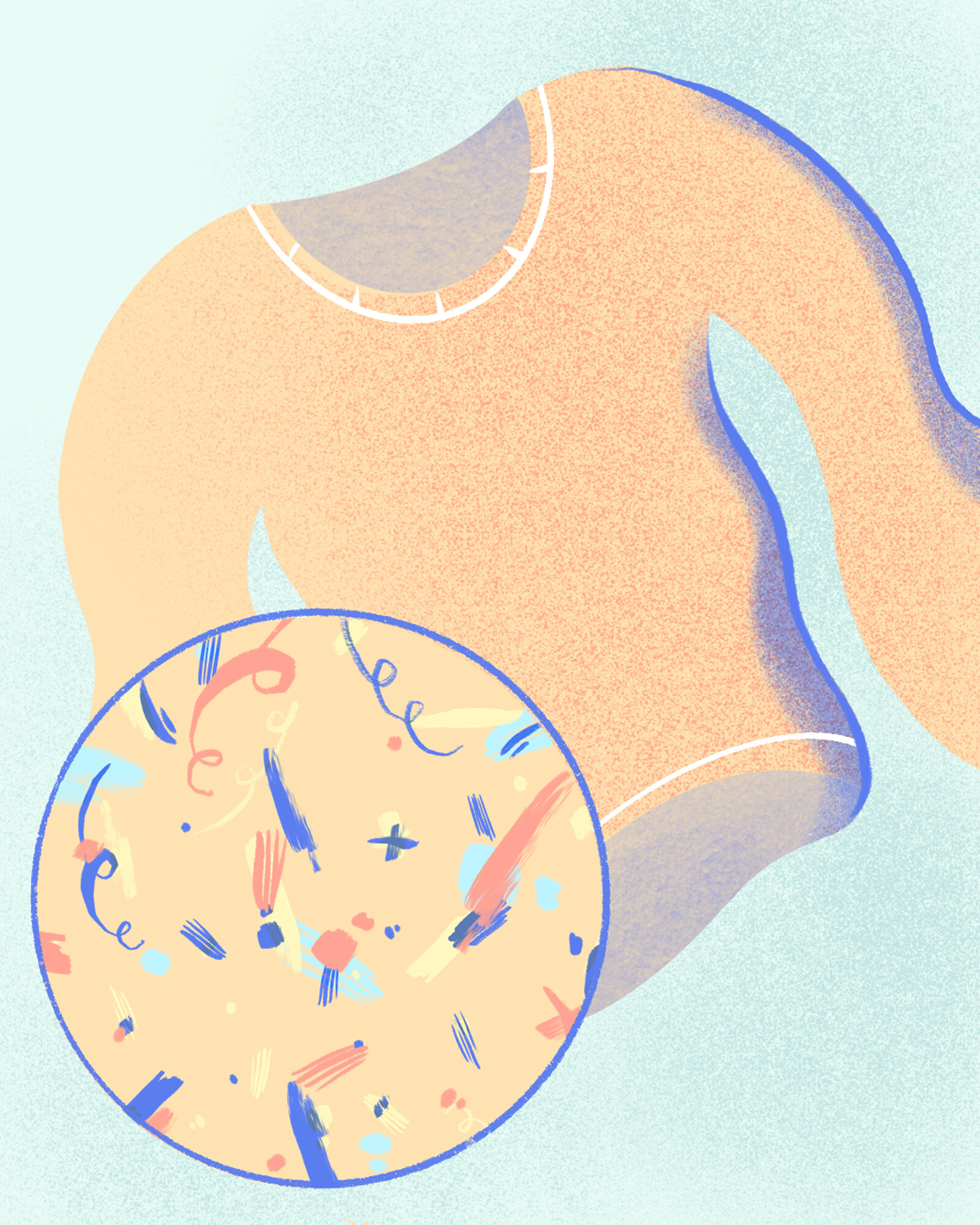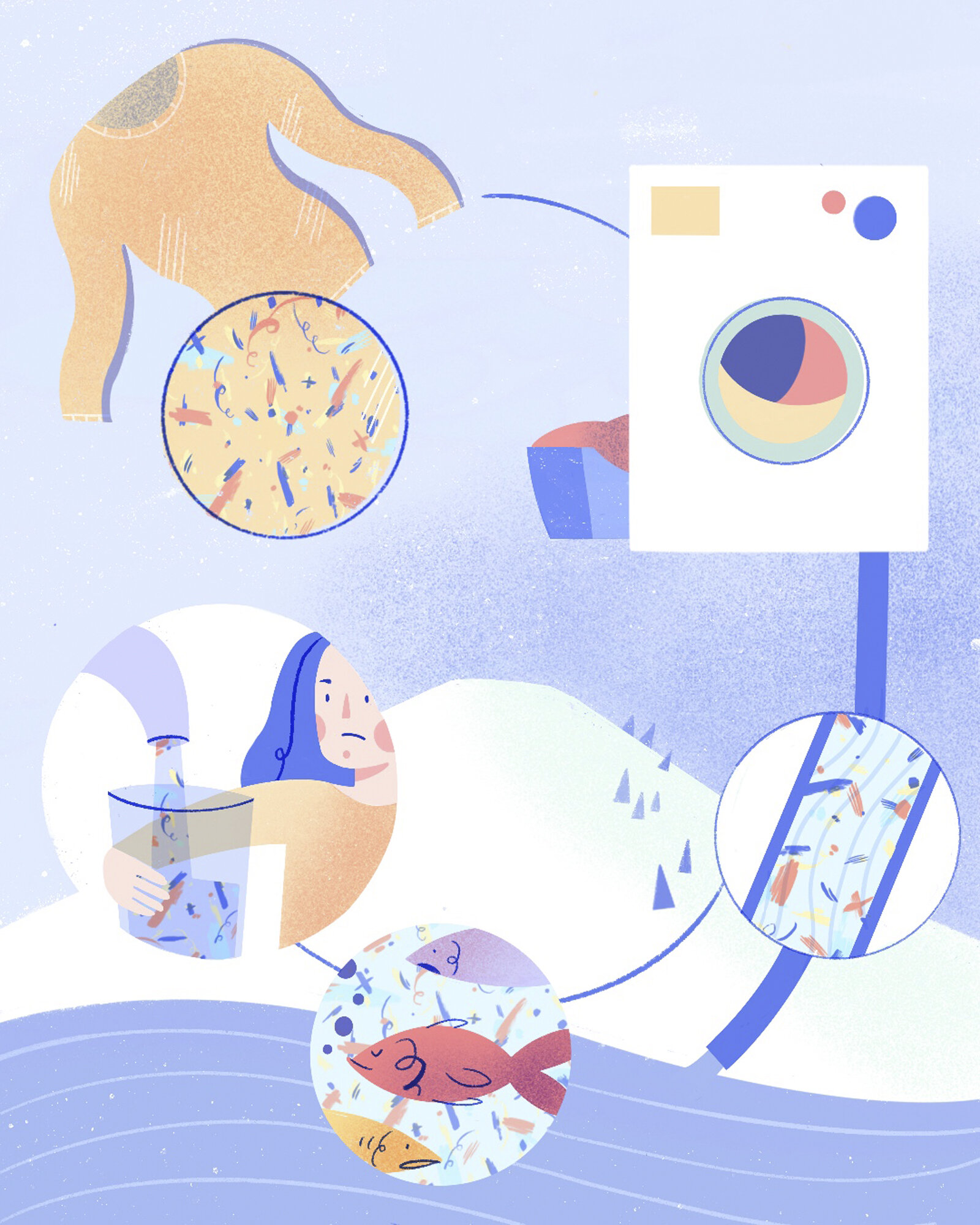Text by Evelina Kaganovitch
Illustrations by Laura Vicente Mesonero
WE WASH OUR CLOTHES ON A REGULAR BASIS, BUT
DO WE EVER STOP TO THINK ‘WHAT HAPPENS IN THE PROCESS’?
Let's talk about the effects our clothes have on the environment during the wash cycle. There is no denying that clean clothes are important to have. But even your most treasured possessions are likely to be damaging the underwater world. Let’s discuss how microfibers are entering our oceans and what environmental impact they are having on nature and sea life. Imagine this... About 525,000 tonnes of microfibers enter the ocean from clothes each year. On top of that, one half of a garments environmental impact occurs only after it leaves the store (1). Now that’s something to think about.
Evelina Kaganovitch | ©️Cherie Birkenr
Hi, I’m Evelina Kaganovitch, an Australian Fashion Designer and Journalist, currently based in Berlin. Being a passionate learner, discussing the effects our clothing has on the environment and my curiosity about the people who create them has brought me to discover the many ways in which we can reduce our environmental impact. Now let’s not sugar-coat the issues we are facing, the best thing we can do is to just consume less. So this year I am challenging myself to not buy new clothes for the entire year!
WHAT ARE MICROFIBERS?
Microfibers are small pieces of plastic. They look similar to a piece of hair, only much thinner and shed from our clothes in the washing process. A microfibers gate into the sea is through our trusty washing machines. They clean our clothes but sadly pollute our oceans. But if the machine is not entirely to blame, then who is at fault? It’s a difficult question to answer. There is no one right answer, and no one perfect solution. Let’s first look at where microfibers go and why they are not good news.
©️Laura Vicente Mesonero
HOW BIG IS THIS PROBLEM REALLY?
All clothes shed microfibers during washing. Regardless of the fabric they are made from. The difference is that natural fibers (i.e cotton or wool) biodegrade when they enter the water stream and synthetics do not. 60% of clothes today contain polyester (2). Polyester tends to carry a bit of a bad reputation. The reason being is that polyester microfibers float through waterways and through sewage systems. This is not a bad thing. Unless they don’t break down. And that’s where the core problem lies. A jacket that is made from synthetic materials releases about 1.17mg of microfibers per wash (3). There are nearly 8 bags of microfibers per person going into the oceans in Europe and Central Asia every single day (2). Those are crazy statistics! The fibers do not break down and circulate through our ecosystem. We see them be absorbed into fish and then they even end up on our dinner plate.
©️Laura Vicente Mesonero
DO ALL GARMENTS RELEASE THE
SAME AMOUNT OF MICROFIBERS?
With every wash millions of tiny fibers detach from our clothes and move through waste-water treatment systems. Because they are so small, they by-pass the facility and go straight into the ocean. Through their research Patagonia has been able to prove that lower quality clothing release more microfibers over the garments life-cycle as compared to high quality garments (1). This is because the threads that are used in higher quality clothes are typically stronger and more tightly spun together, meaning less microfibers are released during washing. This is a good incentive to invest in good quality clothing that lasts. Checking a care label will give you basic information about what materials are in that piece of clothing. Then to find out whether the quality of the garment is good or bad researching the brand is helpful. Also remember that good quality rarely comes with a fast-fashion price tag.
WHAT IS SO BAD ABOUT MICROFIBERS?
In the ocean, the microfibers act as a magnet to other plastics and chemicals that attach themselves onto the fibers. Many of these chemicals are banned due to their toxic properties but they still swim around under the sea. These chemically infused particles can then attach themselves onto the bodies of animals and be absorbed through the skin or mouth. What about humans? We cop a plastic cocktail when it comes to meal time.
The challenge presented by microfibers is how small they are. There are many wastewater treatment solutions designed to trap solid pieces of plastics going into the oceans such as plastic bottles and straws but microfibers are too tiny to be caught. “One washing load of clothes could be shedding up to 17 million tiny plastic fibers” - Friends of Earth (4).
HOW DOES THIS EFFECT THE ENVIRONMENT? Microfiber outputs damage the natural ecosystem. Coral reefs, which do not only uphold life under water, but also protect our coasts from waves, storms, and floods, are bleaching at rapid speed. Rivers, which are used as a source for drinking water, are being polluted by the hour. Bad water quality is stopping new corals from growing (5) and 50% of The Great Barrier Reef has been bleached since 2016 (6).
WHY WE ARE FINDING MORE AND MORE FISH ON A PLASTIC DIET? Plankton and other sea organisms mistake small plastics for food and eat them. Following the natural food chain it then leads fish to eat plankton and in turn consume plastic. One animal we find a lot of plastic in are mussels. Through their research the United Nations Environment Program can confirm that if a sea animal is exposed to plastic particles then there is a very high change it will be absorbed into the tissue of that animal (7).
WHAT YOU CAN DO
It’s important to recognize that the release of microfibers into the oceans is a big challenge facing the world today. And this cannot be solved with one solution or by merely one person. But it’s not all bad news. The first important step is to realize and understand the problem that lies ahead.
This is what you can do to lower your microfiber output:
©️Laura Vicente Mesonero
Use lower temperatures and milder washing programs. A cooler wash is not so aggressive and means less plastic shedding.
Wash inside out. This helps elongate the color intensity of your garments. Fill the washing machine so it’s tightly packed. It creates less friction and less microfibers are released.
Air dry your clothes where possible as the spin cycle also sheds microfibers. Tip: shake your clothes out properly so they can dry without wrinkles - this will also save you energy with ironing.
Choosing natural fibers is a great solution. It’s better for your skin and for nature. By choosing natural materials such as cotton, wool, hemp, silk and linen you can rest assured that anything that goes into nature will break down without ending up in an endless loop of ecosystem pollution. Because the skin is our biggest organ and absorbs so much it’s better to wear clothing that isn’t synthetic so your body doesn’t absorb chemicals into your skin.
Wool is self cleaning, so this only needs to be washed if it has stains, otherwise just hang it out.
Using GUPPYFRIEND wash bags that are designed specifically to trap microfibers. They make it easy to wash your clothes without worrying about polluting the oceans.
Attach a PlanetCare filter so your washing machine, to filter 80- 90% of microfibres from your laundry.
Spread the word online and offline. Use your voice on social media, in conversation with friends, at demonstrations or even through self organized campaigns like ocean now to educate others. The more we talk about what is happening inside our washing machines the less microfibers will float through our seas.
©️Laura Vicente Mesonero














We need to talk. About sharing facts. While fake news is a real phenomenon of the Internet, fact checking has been…